How to get rid of carpenter ants in your home without fumigation
I live in a log house. Every May and June I hear the song, “♫the ants go marching one by one♪” playing in my head. But I don’t think, “Hurrah, Hurrah!” Every spring, when the soaking rains of May and June hit my area, the carpenter ants come to the foundation of my log house, march enmasse up the wall, and move into the logs to get out of the rains. (♫Boom, Boom, Boom♪). (Go on. Admit it. It went through your head, too.)
I hear them chewing on the logs in the still of the night. Those carpenter ants walk across my wooden floors looking for food. At the peak of the invasion, they push sawdust out of the logs, on the edges of the trim.
You can see the sawdust gathering behind the window trim. Sometimes it even pushes out of the electrical boxes, creating a fire hazard. This annual battle is infuriating. If you live in a wooden house in the country, you probably face this annual invasion as well. I bet you’d love to find out how to get rid of ants?
I could call an exterminator and have my home fumigated with poisonous gasses, but it wouldn’t end the problem. They’d just come back when the poison abated.
I could squish every ant I find or vacuum them up, but it wouldn’t impact the colony. You see the queen will continue laying eggs and the scouts will continue to leave the colony, across my floors, every night looking for food. It can be demoralizing to be defeated by such a tiny creature.
Cleaning up the mess doesn’t help, either, because they are back at their work the very next day. Ants are determined creatures. However, I’ve found an effective, organic way to get rid of carpenter ants in my home, without endangering my family or my pets.
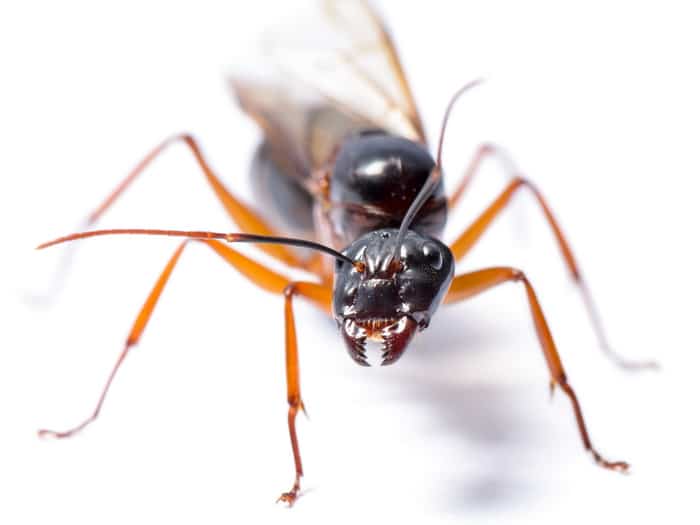
Close up of Black Carpenter Ant or Camponotus pennsylvanicus (winged male). Look at those jaws!
My Effective Step by Step Plan for dealing with carpenter ants in your home
Step one: Determine the entrances to the carpenter ant colony. You may need to remove the trim from a window or remove the cover from an electrical plug to find the entry way from the outside wall into your home. The ants leave a trail of sawdust. That sawdust is the residues of their tunnels into your wooden home. It will contain body parts of dead ants, and debris from the tunnels that the ants have made in your walls. Vacuum up the debris and sawdust.
You will find live ants in the sawdust, too. Vacuum these up as well. Follow their path. The ants are coming out of the wall through a small hole in the wood, not much bigger than a nail hole, perhaps, although they will make this entrance bigger as they continue to use that door way. The bigger the doorway, the longer you’ve had the infestation, and the more damage to your house.
Step two: Watch the hole carefully. You will probably see other ants coming out of the hole in a few minutes. You actually want this so don’t kill these guards.
Step three: Mix up your secret weapon. This secret weapon is nontoxic to you but is deadly to ants. The goal is to have the guard ants take this secret weapon back to the queen. It will kill her, stop her from laying eggs, and the colony will leave or die off.
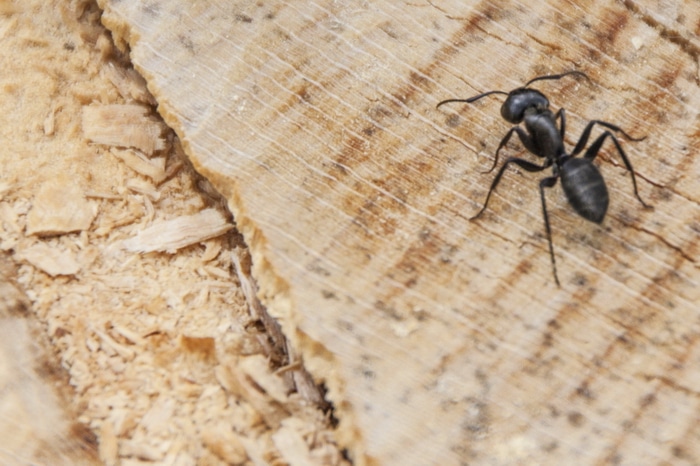
My secret weapon to get rid of carpenter ants
You are going to make two different formulas of this effective weapon.
You need:
A spoon
1 – 2 tbsp. of jam or jelly, (This is a good use for that jam that didn’t quite set.)
A cardboard egg carton – cut off 1 of the egg cups from the edge of the carton to hold your mixture
1 to 2 teaspoon Boric Acid from the pharmacy – do not use borax from the laundry aisle.
1 – 2 tablespoon Corn flour
For formula 1:
Mix ½ teaspoon of boric acid with just enough jam or jelly to make a thick paste. Put it into one of the cardboard egg cups and put near the entrance to the colony. Leave it overnight.
The ants will come and taste the jam/boric acid mix and will take some of the mixture back to the queen. Ants taste with their feet, so if you see the ants walking on the jelly mixture, this is a good thing. Don’t kill these ants. They need to stay alive so that they can feed the queen.
For formula 2:
Step 1: Mix ½ teaspoon boric acid with enough jam to make a thick paste. Add to this enough corn flour to make it the consistency of putty. Knead this well with your fingers until it is moldable. In the morning, plug the hole into the colony by pushing this putty into the hole as far as you can. Use a butter knife to smooth it over and seal up the hole. It will harden in place.
Step 2: Leave any remaining putty and the egg cup of jam/boric acid mixture near the entrance hole until you know the colony is gone and the chewing sounds stop.
Step 3: Vacuum up any ants that remain outside the colony.
Step 4: Wait.
After 3 to 5 days the gnawing on your house and the chewing sounds will stop. If the ants make a new hole beside the first hole, they will ingest the boric acid/jam mixture that you’ve left for them. Plug up any new holes that the ants make, with the corn flour/boric acid/jam putty.
I’ve never had this method fail to remove an ant colony within a week, and usually between 3 and 5 days.
Step five: You win! Put the trim back up, remove the boric acid. You can leave any of the corn-jam boric acid in place, on your walls. It will harden in place and will continue to provide protection in that spot. Remove the jam-boric acid egg cup. You can use this to deal with invasive ant nests in your garden.(See below.)
Note: Be sure that you are using pure boric acid and not borax. Borax has other chemicals and fragrance that will alert the ants that something is not right. Boric acid is odourless. You can buy boric acid here. You don’t need much to get rid of a whole colony of ants. (Boric acid has no expiry date.)
Precautions:
Keep boric acid away from children and babies. The label warning indicates that it is an eye and skin irritant. Wash your hands well after touching it. Don’t leave it where young children might eat it.

Other methods of pest control that don’t work:
Applying borax around the foundation of your home
Some folks recommend applying borax around the foundation of your home to repel carpenter ants. There’s a few problems with this method of discouraging carpenter ants.
First it has to be reapplied after rainfall or heavy dew. It is ineffective if it rains. This can be expensive. It takes 3 boxes of borax to make a 2 inch wide path around the perimeter of my log house. That can add up, especially in May, when it’s raining. It’s in the May rains that the ants move from the outdoors into my log house.
It’s ineffective. The queen carpenter ants have wings in the Spring and simply fly to the side of your house and burrow in, to begin laying eggs. No chemical barrier laid on the ground is going to keep them back. When you see ants marching up the side of your house, they are simply bringing food to an already established colony, not actually moving in for the first time.
Adding a chemical barrier will make you think you are controlling their entrance, but they will find a new way to get back “home”.
While plants need some boron in the soil, boron is a trace element and in large amounts will inhibit the growth of plants, leaving the foundation of your home barren and dusty, encouraging soil erosion.
Fumigation:
Fumigation is toxic. It kills everything including spiders, moths, and any other insect that might be using your home as a winter shelter. It’s effective against some infestations like roaches. But it is useless against carpenter ants that are living in the exterior walls of your home. There are always tunnels to the fresh air and the ants are impervious to the toxic fumes. Fumigation has to be done by a professional. It’s expensive. It will leave a toxic residue in your home.

How to get rid of ants in the garden
We live on 140 acres and there are lots of room for fire ants to build their homes. Bears come around in the spring and keep the ant population under control, without destroying the colonies completely. I’m ok with that and it fascinates me to watch how quickly an ant colony is rebuilt after being foraged on by a bear.
But in my home or in my garden I need them to move on. While I get an annual infestation of carpenter ants in my home, that is quickly dealt with, in the garden it’s fire ants that invade. When the fire ants take over a raised bed, just weeding beside the bed, results in swarming ants and burning stings. Plants in the bed with the ant colony die back. The ants place aphids on the plants, and plants in other parts of the garden are also harmed by the activity of the ants.
I’ve tried pouring boiling water on a colony. This makes the ants pretty mad but doesn’t get rid of the colony. I’ve tried digging the nest up and moving it to the pasture, the ants return. But the boric acid-jam mixture has been 100% effective in clearing the garden beds of an ant colony. Simply place the cardboard egg cup filled with the boric acid-jam mixture directly on top of the ant nest and walk away. Don’t disturb the nest. Even if it rains, this method is effective in about 3 to 5 days.
Next time you hear carpenter ants gnawing on your country home, or you get swarmed by fire ants in the garden, while weeding the mint, reach for boric acid and the homemade jam that didn’t quite set. You’ll be free of the ant problem in a few days.
Now that you know how to deal with carpenter ants, get more money saving, low impact, self reliant tips
42 Zero Waste Habits for Living Green that Will Save You Money
7 Things Grandpa Did That Made His Tools Last Longer
25 Cheap Gardening Tricks for Self-Reliance


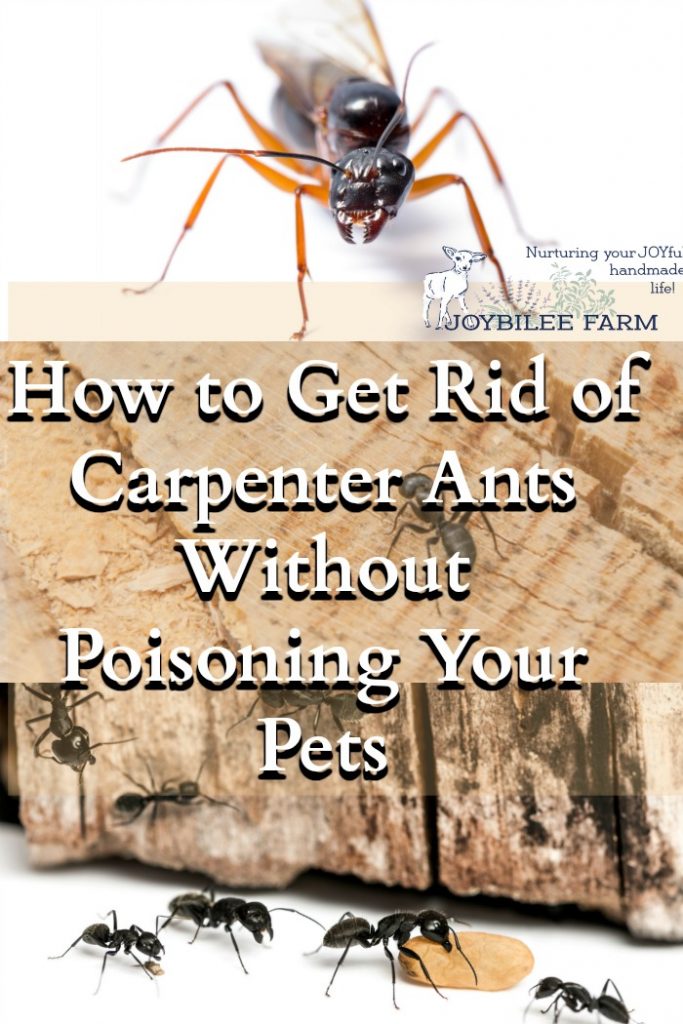
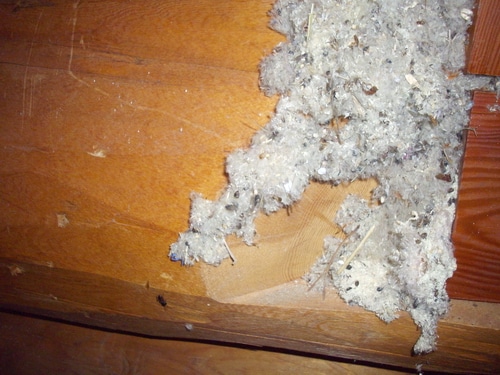
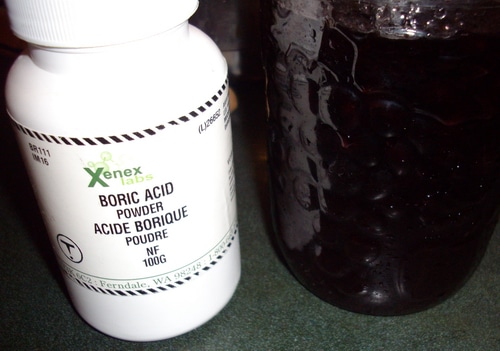
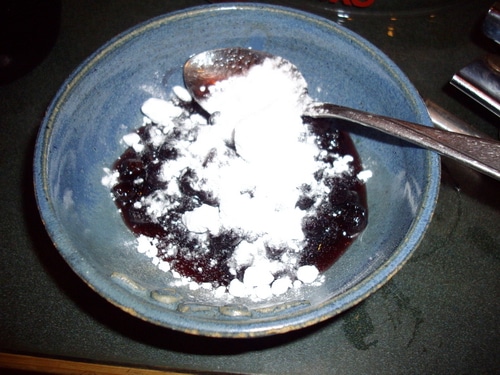

Found your post while searching for ways to get rid of carpenter ants. I too live in a log cabin, and after heavy rains, am being invaded by them!!! We came home after dark on the Fourth of July, and they were all over our porch! We have 2 cats and a dog plus have chickens & honeybees, so we try to stay away from regular pesticides. Thanks! I’m going to get some boric acid and mix up now!
Use apple cider vinegar to clean around where they are coming in. There is a pharamone trail you have to get rid of befor they will notice the bait. We had the same problem and did a little reading on it. Hope that helps you out.
Thanks for sharing your experience. We noticed this year that they will also avoid cinnamon. So if you can put a circle of powdered cinnamon spice around your camp it might prove helpful.